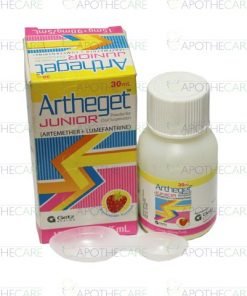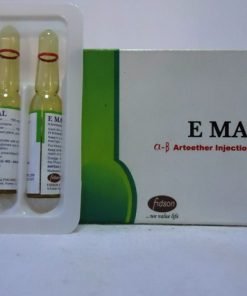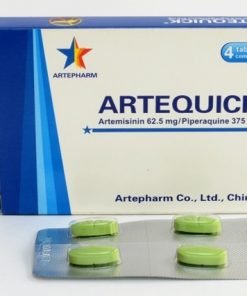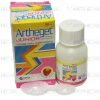Please Note!
ALL ORDERS WE RECEIVE ON OR BEFORE 6:00PM (LOCAL TIME) WILL BE PROCESSED AND DISPATCHED TO YOU THE SAME DAY.
Artheget suspension
₦1,200.00
ARTHEGET (Artemether+Lumefantrine) is indicated for the treatment of uncomplicated infections with plasmodium falciparum, including multi-drug resistant strains in adult, children and infants of 5 kg and above.
Out of stock
Description
DESCRIPTION
ARTHEGET, Artemether and lumefantrine combination is a fixed dose artemisinin-based combination therapy (ACT) combining artemether, an artemisinin derivative, and lumefantrine, a synthetic anti-malarial drug Artemether, a sesquiterpene lactone derivative of naturally occurring substance, artemisinin. Chemically it is (3R, 5aS, 6R, 8aS, 9R, 10S, 12R, 12aR)-Decahydro-10-methoxy-3,6,9-trimethyl-3, 12-epoxy-12Hpyrano[4.3-j]1,2-benzodioxepin. Tile molecular formula is C16H26O5 and the structural formula s
Artemether
Lumefantrine is a synthetic aryl-amino alcohol anti-malarial (1R-S)-2-Dibutylamino-1-(2,7 -dichloro-9-[(Z)(4-cholorobenzylidene )-9H-fluoren-4-yl}-ethanol. The molecular formula is C30H32Cl3NO and the structural formula is:
CLINICAL PHARMACOLOGY
Mechanism of Action
The site of anti-parasitic action of both components is the food vacuole of the malarial parasite, where they are thought to interfere with the conversion of haem, a toxic intermediate produced during hemoglobin breakdown, to the nontoxic hemozoin, malarial pigment. Lumefantrine is thought to interfere with the polymerization process, while artemether generates reactive metabolites as a result of the interaction between its peroxide bridge and haem iron.
Both Artemether and Lumefantrine have a secondary action involving inhibition of nucleic acid and protein synthesis within the malarial parasite. The anti-malarial activity of the combination of lumefantrine and artemether In ARTHEGET (Artemether-lumefantrine) is greater than that of either substance alone.
Pharmacokinetics
Absorption
Artemether is absorbed fairly rapidly with peak plasma concentrations reaching about 2 hours after dosing. Absorption of lumefantrine a highly hpophilic compound, starts after a lag-time of up to 2 hours, with peak plasma concentration about 6-8 hours after dosing. Food enhances the absorption of both Artemether+Lumefantrine. In order to improve bioavailability patients should be encouraged to take the drug with food
Distribution
Artemether+Lumefantrine are both highly bound to human serum proteins in vitro (95.4% and 99.7%, respectively). The artemisinin metabolite dihydroartemisinin is also bound to human serum proteins (47%-76%).
Metabolism
Artemether is rapidly and extensively metabolized (substantial first pass metabolism) by human liver microsomal enzyme mainly by CYP3A4/5 to the biologically active metabolite dihydroartemisinin. Lumefantrine is N-butylated, mainly by CYP3A4 in human liver microsomes.
Elimination
Artemether and dihydroartemisinin are rapidly cleared from plasma with an elimination half-life of 2 hours. Lumefantrine is eliminated very slowly with a terminal half-life of 2-3 days in healthy person and 4-6 days in patients with falciparum malaria.
Indications
ARTHEGET (Artemether+Lumefantrine) is indicated for the treatment of uncomplicated infections with plasmodium falciparum, including multi-drug resistant strains in adult, children and infants of 5 kg and above.
Contra-indications
Artemether+Lumefantrine combination is contraindicated in Patients with known hypersensitivity to the active substances or to any of the excipients.
Patients who are taking any drug which is metabolized by the cytochrome enzyme CYP2D6 (e.g. flecainide, metoprolol, imipramine, amitryptyline, clompiramine).
Patients with a family history of sudden death or congenital prolongation of the QTc interval on electrocardiograms, or with any other clinical condition known to prolong the QTc interval and those drugs which are known to prolong the QTc interval (e.g antiarrnythmics of classes IA and III, narcoleptics, anti-depressive agents, macrolides, fluoroquinolones, imidazole and triazole antifungal agents, non-sedating antihistamines like terfenadine, astemizole and cisapride).
Patients with a history of symptomatic cardiac arythmias or with clinically relevant bradycardia or with congestive cardiac failure accompanied by reduced left ventricle ejection fraction. Patients with disturbances of electrolyte balance e.g. hypokalemia or hypomagnesemia.
In patients previously treated with halofantrine, Artemether+Lumefantrine should not be administered earlier than one month after the last halofantrine dose.
Artemether+Lumefantrine tablets are not indicated for prophylaxis, or for treating severe malaria, including cerebral malaria, or malaria with pulmonary edema or renal failure. It is also not indicated for and has not been evaluated in, the treatment of malaria due to P.Vivax, P.malariae or P.ovale.
Artemether+Lumefantrine combination tablets are contraindicated during the first trimester of pregnancy. However, it should not be withheld in life-threatening situations, where no other effective anti-malarials are available.
Women taking Artemether+Lumefantrine combination tablets should not breast-feed during their treatment
Precautions/Warnings
Due to limited data on safety and efficacy, Artemether+Lumefantrine should not be given concurrently with any other anti-malarial agent unless there is no other treatment option
Caution is advised when administering Artemether+Lumefantrine tablets to patients with severe renal, hepatic or cardiac problems. In such cases, monitoring of the ECG is recommended and steps should be taken to correct any electrolyte disturbances.
Caution is recommended when combining Artemether+Lumefantrine tablets with drugs exhibiting variable patterns of inhibition, induction or competition for CYP3A4 as the therapeutic effects of some drugs could be altered.
If quinine is given after Artemether+Lumefantrine tablets then close monitoring of ECG is advised, while if Artemether+Lumefantrine tablets are given after mefloquinine, then close monitoring of food intake is required.
Patients receiving Artemether+Lumefantrine combination should be warned that dizziness or fatigue/asthenia might occur in which they should not drive or use machines.
Patients who remain averse to food during treatment should be closely monitored as the risk of recrudescence may be greater. The long elimination half-life of lumefantrine must be taken into account when administering quinine in patients previously treated with Artemether+Lumefantrine combination.
Like other antimalarials e.g., halofantrine, quinine and quinidine) Artemether+Lumefantrine combination has the potential to cause QT prolongation
Interactions
Interaction with other antimalarials
Mefloquine
Pre-treatment with mefloquine has no effect on plasma concentrations of artemether or the artemether/dihydroartemisinin ratio but there was a significant reduction m plasma levels of lumefantrine. Patients should be encouraged to eat at dosing times to compensate for the decrease in bioavailability.
Quinine:
Infusion of quinine alone caused a transient prolongation of the QTc interval, which was consistent with its known cardiotoxicity. Thus, prior administration of Artemether+Lumefantrine combination appears to enhance the inherent risk of QTc prolongation from IV quinine.
Interaction with CYP450 3A4 inhibitors Ketoconazole :
The concurrent oral administration o ketoconazole with Artemether+Lumefantrine combination led to a modest increase (<2-fold) in artemether, DHA, and lumefantrine exposure in healthy subjects. Dose adjustment of Artemether+Lumefantrine is considered unnecessary in falciparum malaria patients when administered in association with ketoconazole or other potent CYP3A4 inhibitors.
Halofantrine:
In vitro studies indicated that lumefantrine metabolism is inhibited by halofantrine. In patients previously treated with halofantrine, Artemether+Lumefantrine combination should be dosed at least one month after the last halofantrine dose.
Pregnancy:
During the second and third trimester, treatment with Artemether+Lumefantrine combination tablets should only be considered if the expected benefit to the mother outweighs the risk to the fetus.
Nursing mothers:
Due to the long elimination half-life of lumefantrine (4 to 6 days), it is recommended that breast-feeding should not resume until at least one week after the last dose of ARTHEGET (Artemether+Lumefantrine) unless potential benefits to the mother and child outweigh the risks of ARTHEGET (Artemether+Lumefantrine) treatment.








Reviews
There are no reviews yet.